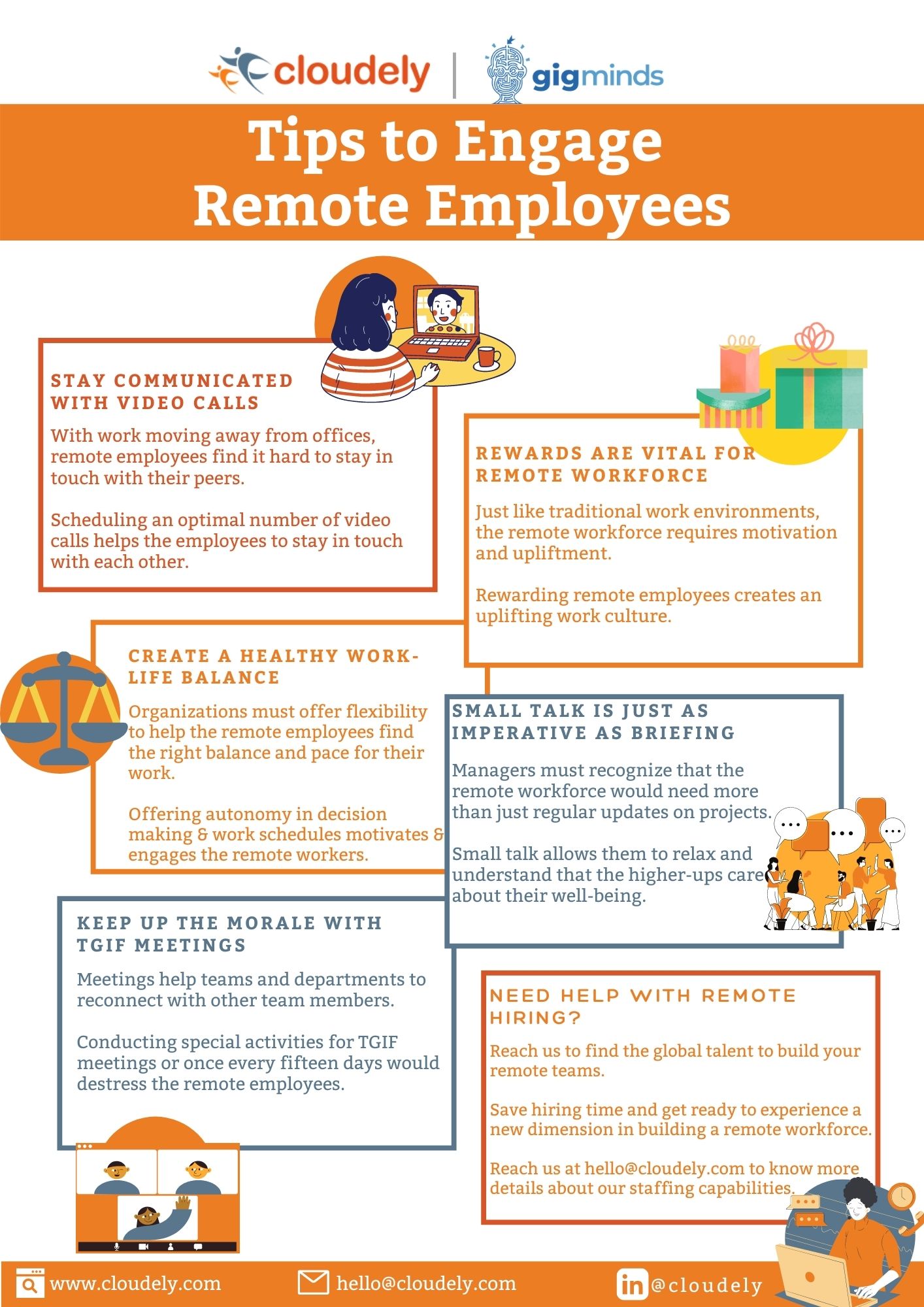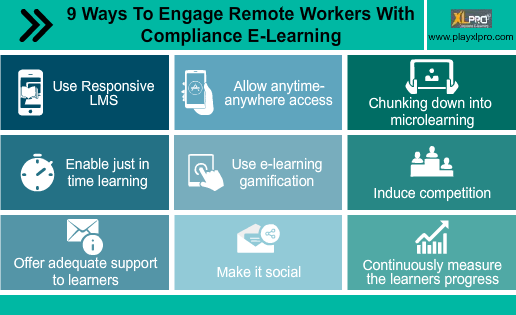How To Engage Remote Employees?
To engage remote employees, establish clear communication channels and provide regular feedback and recognition. This will foster collaboration and boost motivation, ensuring a positive and productive remote work environment.
As more companies transition to remote work models, engaging employees who are physically distant presents a unique challenge. With limited face-to-face interaction, fostering a sense of connectivity, motivation, and productivity is crucial for sustaining a successful remote workforce. Effective engagement strategies prioritize clear communication channels, regular feedback and recognition, and opportunities for collaboration.
By implementing these strategies, organizations can create a positive remote work environment that not only maintains employee morale but also drives productivity and teamwork. We will explore actionable tips and tactics to engage remote employees effectively.
Building A Strong Remote Culture
Developing a strong remote culture is crucial for engaging and motivating remote employees. Without a physical presence in the office, remote employees may feel disconnected and isolated. To combat this, organizations must prioritize building a positive remote culture that fosters collaboration, communication, and a sense of belonging. In this article, we will explore two essential elements of building a strong remote culture: encouraging open communication and fostering collaboration.
Encouraging Open Communication
Open communication is the foundation of any successful remote team. When employees feel comfortable expressing their thoughts, concerns, and ideas, it not only enhances productivity but also strengthens the team’s bond. To encourage open communication in a remote work environment, organizations can:
- Implement regular check-ins: Schedule regular one-on-one meetings with remote employees to discuss their progress, challenges, and feedback. This gives them a dedicated space to share their thoughts and ensures their voice is heard.
- Utilize communication tools: Make use of various communication tools, such as instant messaging platforms, video conferencing software, and project management systems. These tools promote real-time communication, facilitate collaboration, and keep remote employees connected.
- Create a virtual water cooler: Establish a virtual space for casual conversations, similar to a physical break room. This can be a designated chat channel or forum where employees can connect, share personal experiences, and engage in non-work-related conversations.
Fostering Collaboration
Collaboration is key to driving innovation and achieving shared goals in remote teams. When employees collaborate effectively, they can tap into the diverse knowledge, experiences, and perspectives within the team. To foster collaboration in a remote work environment, organizations can:
- Promote team-oriented goals: Set clear team goals that require collaboration and emphasize the importance of working together towards achieving them. This creates a shared sense of purpose and encourages remote employees to collaborate with their colleagues.
- Encourage virtual team-building activities: Organize virtual team-building activities and events to strengthen relationships and build trust. This can be anything from virtual happy hours and online games to team challenges and virtual workshops.
- Establish collaboration spaces: Utilize collaboration tools that allow remote employees to work together on projects in real-time. This could be a shared document or a virtual whiteboard where team members can contribute their ideas, provide feedback, and collaborate seamlessly.

Credit: cloudely.com
Effective Remote Leadership
Effective remote leadership is crucial for engaging and motivating remote employees. When managing a remote team, it is essential to set clear expectations, provide regular feedback, and establish a strong communication channel. By adopting these practices, leaders can foster a positive work environment, boost productivity, and ensure the success of remote employees.
Setting Clear Expectations
Setting clear expectations is the foundation of effective remote leadership. Remote employees need to understand what is expected of them in terms of tasks, deadlines, and deliverables. This clarity allows them to plan their work accordingly and stay focused on their goals. Here are some steps leaders can take to ensure clear expectations:
- Define specific goals and objectives for each remote employee.
- Clearly communicate the scope of work, deadlines, and priorities.
- Provide detailed instructions and resources to assist employees in completing their tasks.
- Encourage remote employees to ask questions and seek clarification whenever needed.
Providing Regular Feedback
Regular feedback plays a vital role in remote employee engagement. Without face-to-face interactions, remote employees may feel disconnected and unsure about their performance. Providing feedback helps keep them motivated, aligned with expectations, and fosters continuous improvement. Here’s how leaders can provide effective feedback to remote employees:
- Schedule periodic check-ins to discuss progress, challenges, and accomplishments.
- Offer constructive criticism while highlighting areas of improvement.
- Recognize remote employees’ achievements and acknowledge their hard work.
- Provide specific examples and actionable recommendations to help remote employees enhance their performance.
By setting clear expectations and providing regular feedback, leaders can empower remote employees, boost their confidence, and create a sense of belonging within the team. Effective remote leadership is the key to fully engaging remote employees and driving their success.
Supporting Remote Employees’ Well-being
When managing remote employees, it is crucial to prioritize their well-being to ensure their productivity and job satisfaction. Supporting their well-being involves promoting work-life balance, offering mental health resources, and encouraging physical wellness. Let’s explore each of these aspects in detail:
Promoting Work-life Balance
Work-life balance is essential for remote employees to maintain a healthy and sustainable work routine. Here are some effective strategies to promote work-life balance:
- Set clear boundaries: Encourage employees to establish specific working hours and communicate them to their team. This helps create a balance and avoid overworking.
- Flexible schedules: Allow employees to have flexibility in their schedule, enabling them to accommodate personal commitments alongside work responsibilities.
- Encourage breaks: Emphasize the importance of taking regular breaks throughout the day. Encourage employees to step away from their screens, stretch, or engage in quick relaxation activities.
- Promote vacation time: Encourage employees to utilize their vacation time and take time off for relaxation and rejuvenation.
Offering Mental Health Resources
The remote work environment can sometimes lead to feelings of isolation and stress. Providing mental health resources can significantly improve employees’ well-being. Here are some ways to offer support:
- Employee assistance programs: Provide access to employee assistance programs that offer counseling, therapy, and mental health support.
- Virtual wellness workshops: Organize virtual workshops on stress management techniques, mindfulness, and other mental health practices.
- Regular check-ins: Schedule regular one-on-one check-ins with employees to discuss their well-being and provide a supportive space for them to express any concerns.
- Encourage self-care: Remind employees to prioritize self-care activities such as exercise, meditation, and hobbies.
Encouraging Physical Wellness
Physical wellness plays a vital role in maintaining overall well-being. As a remote employer, you can encourage your employees to prioritize their physical health with the following strategies:
- Provide ergonomic guidance: Share tips and resources on setting up an ergonomic workspace to prevent any work-related injuries.
- Encourage exercise breaks: Suggest short exercise breaks during the workday, such as stretching exercises or a quick walk.
- Virtual fitness challenges: Organize virtual fitness challenges that encourage employees to engage in physical activities and promote a healthy lifestyle.
- Health and wellness resources: Share information on nutrition, healthy eating habits, and maintaining an active lifestyle.
Virtual Team Building Activities
Virtual team building activities are crucial for keeping remote employees engaged and connected. When employees are working from different locations, it can be challenging to foster a sense of teamwork and camaraderie. However, with well-planned virtual team building activities, organizations can create a positive work culture and enhance productivity.
Organizing Virtual Social Events
Virtual social events are a fantastic way to bring remote employees together and foster social connections. By organizing regular social events, such as virtual happy hours or informal team gatherings, employees can engage in casual conversations and build relationships beyond work tasks. These events can include interactive activities like online trivia games or virtual escape rooms to keep employees entertained and encourage collaboration.
Implementing Team Challenges
Team challenges are an effective way to boost employee engagement and promote healthy competition among remote teams. These challenges can be structured based on specific goals or projects and can range from simple tasks to complex projects that require teamwork and problem-solving skills. Implementing regular team challenges encourages employees to work together, communicate effectively, and learn from one another’s strengths, thereby enhancing their collaboration and productivity.
Leveraging Technology For Engagement
In today’s increasingly remote work environment, it’s essential for businesses to find effective ways to engage their remote employees. One powerful tool for accomplishing this is technology. By utilizing technology, companies can create a sense of connection and collaboration among their remote workforce. In this post, we will explore two key strategies for leveraging technology to engage remote employees: utilizing project management tools and implementing video conferencing.
Utilizing Project Management Tools
Project management tools are invaluable when it comes to engaging remote employees. These tools provide a centralized platform where teams can collaborate, track progress, and share documents. By utilizing project management tools, companies can foster transparency and accountability, which are essential for remote teams. Additionally, these tools allow employees to stay organized and prioritize their tasks, ensuring they stay on track and meet deadlines.
Implementing Video Conferencing
Video conferencing is a game-changer when it comes to engaging remote employees. Rather than relying solely on emails and phone calls, video conferencing provides a face-to-face interaction that helps strengthen relationships and foster a sense of belonging. Employees can hold virtual meetings, share screens, brainstorm ideas, and engage in real-time discussions. This technology allows remote teams to collaborate more effectively, resulting in increased productivity and engagement.

Credit: visme.co

Credit: www.oysterhr.com
Frequently Asked Questions For How To Engage Remote Employees?
How Can You Effectively Engage Remote Employees?
To engage remote employees effectively, establish clear communication channels, provide regular feedback and recognition, and promote team collaboration through virtual team-building activities.
What Strategies Can Companies Implement To Keep Remote Employees Motivated?
Companies can keep remote employees motivated by setting clear goals, offering flexible work schedules, fostering a positive work environment, and providing opportunities for professional development and growth.
What Are Some Effective Ways To Build Trust With Remote Employees?
Building trust with remote employees can be achieved by promoting transparency, encouraging open communication, demonstrating consistency in decision-making, and ensuring equal opportunities for remote employees to contribute and be heard.
Conclusion
Fostering engagement among remote employees can significantly impact their productivity and job satisfaction. By implementing effective communication strategies, providing the right tools and technology, promoting a positive work culture, and offering opportunities for professional development and recognition, organizations can create a supportive and engaging remote work environment.
Remember that engagement is a continuous process that requires constant effort and adaptation to meet the unique needs of remote teams. Prioritizing employee engagement will ultimately lead to stronger connections, higher levels of motivation, and improved overall performance.



